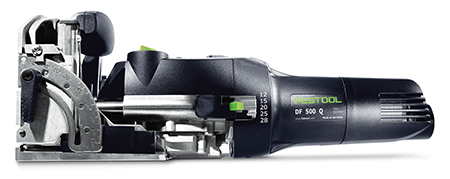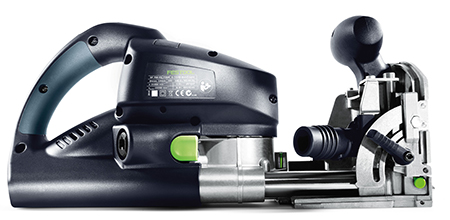The Festool Domino Revolutionises Joining Methods and Techniques
Bring the 21st century to your workshop or jobsite with the Festool Domino mortise and tenon jointing technique.
15/03/2022
The Master System for Wood Joining
When it comes to joining wood, there is a huge array of options at your disposal: nailing, screwing, glueing, and a host of other joinery options. The challenge in joining wood, however, is not just joining it – but picking a joining method that is both strong enough for the wood’s intended use and one that does not alter the appearance in a negative way. Woodworkers, carpenters, and joiners have been limited when it comes to certain applications, whether you are assembling a custom wood door, designing and manufacturing cupboards and cabinets, or creating a custom piece of furniture.
With a professional finish being the ultimate goal, access to expert tools significantly limits joinery options. The last thing any woodworker, carpenter, joiner, or DIY enthusiast wants to see is nails or visible screws on a craftsman piece of furniture. For this, you do not have many options or the time to master complicated joinery methods, which is why the Festool Domino is the absolute solution.
“Some may be unaware of the Festool Domino Jointing System or perhaps you have only heard it mentioned occasionally, but you should know that this tool lives up to the hype it has generated. Costa Stavrakis, Festool SA Brand Manager, can confirm that the Festool Domino is most definitely a tool you will want to invest in if you do any type of wood joinery. "The Festool Domino is the only tool on the market that uses the advantageous and well-used benefits of mortise and tenon joinery. For those that don't know, mortise and tenon joinery is a strong jointing method with zero visible fasteners. Using the Festool Domino for jointing also lets you speed up your assembly process without sacrificing precision,” said Stavrakis.
Festool Domino DF 500
Available in two models, the Festool Domino range consists of the Festool Domino DF 500 and Festool Domino XL. The Domino DF 500 is the smaller version of the domino range and ideal for the DIY enthusiast or SME start-up. This model is capable of using Domino tenons ranging from 4mm to 10mm thick. The Domino XL expands functionality to a larger, more diverse set of wood joining applications and allows for tenon sizes ranging from 8mm to 14mm thick Dominos.
Festool Domino XL
At their core, however, the functionality of both is the same: pick a Domino tenon for the specific pieces of wood you are joining, and the Domino’s unique cutting motion creates a perfect mortise to accept it. Setting up either Domino model is quickly achieved for precise results, with the mortise being cut in mere seconds. Both Domino models are versatile in that they offer varied alignment options, both with similar ease and speed.
Which Domino joiner you choose simply depends on the size Domino tenon you are using. The Festool tenon is much thicker and stronger than a traditional biscuit joiner.
First launched on the market in 2007, Festool's Domino machine has established a new standard - one that offers efficient floating tenon joinery. Introduced as part of the Domino range in 2012, the XL model super-sizes the original concept to cover the application of this tool for larger-scale projects.
So how does the Festool Domino work? “For anyone with basic woodworking experience, the learning curve is quite small. I use the Festool Domino DF 500 any time I want a tight, strong joint with no visible fasteners, typically for interior applications as well as exterior. "Having previously used the Festool Domino DF 500 for joining timber and board, plywood, wood wall panels, large mouldings, and shelving, as well as a variety of furniture projects, while the type of project will vary for users, purchasing the Festool DF 500 handles almost 80% of the joining tasks that most woodworkers, carpenters, joiners, or DIY enthusiasts require,” said Stavrakis.
For any type of jointing with the Domino system, there are primarily two settings you need to make: the depth of the mortise, and the vertical alignment of the cut. When setting the depth on the Festool Domino, you have the ability to centre the tenon to rest equidistance on either side of the joint, or you can select to offset the tenon so that more of it rests on one side. This comes in handy when performing complex joining tasks. Adjusting the depth is simply a case of moving the depth adjustment lever on the side of the Domino, a process that is incredibly quick and simple. Not only can you adjust the mortise depth to suit, but you can also choose to adjust the mortise width from three different settings to create tight-fitting tenons and mortises that provide far more flexibility from an alignment viewpoint.
Adjusting the vertical alignment of any cut is set by adjusting the fence height. For setting the height, you have two options: use one of the Domino’s presets on the board thickness gauge, which covers a variety of standard board thicknesses and centres the mortise on the thickness specified; or you can use the Domino’s height gauge, which shows the distance from the bottom of the Domino fence to the centreline of the mortising bit. As with setting the mortise depth of cut, varying the height of the fence height or adjusting the settings on the board thickness gauge is fast and takes only seconds to accomplish. When you are joining two angles, you can also adjust the angle of the fence, perfect for joining a variety of different mitred pieces.
At the end of the day, there are two key elements to keep in mind when first using either Domino system, and once you realise how easily they work, the rest is a breeze.
Costa Stavrakis goes on to explain, "One of the key features of both Domino systems is precision, and below is a quick real-world example:
Let us say you want to join two boards or two pieces of 25mm plywood together. After adjusting the two settings mentioned above, i.e., setting both the mortise depth and vertical alignment, the next step is to align the unit for the first mortise. The Domino has built-in indexing pins that are simply butted against the edge of your workpieces that eliminate any measuring or marking. From this point on, you have two options. You can align your two pieces of wood, mark measurements every 150mm (or whatever distance you would like), align the Domino to each pencil mark, and make the cuts. The other option, and one highly recommended, is to purchase the Domino set that includes the trim and cross stops. Using the cross stops, you are provided with a measurement scale and a bigger set of indexing pins. Set the distance you want between each mortise, align the cross stop’s indexing pin inside the mortise you previously cut, and you get perfectly spaced mortises without the need to measure or even mark your workpieces.
When joining timber or panelboards, plywood or shelving, the speed of the Domino system is simply remarkable and will change the way you work.
The possibilities involved in Domino joining are vast and its versatility is unprecedented in this type of joinery. Once you have invested in a Domino system you will discover many different ways you can use it on a huge variety of projects.








